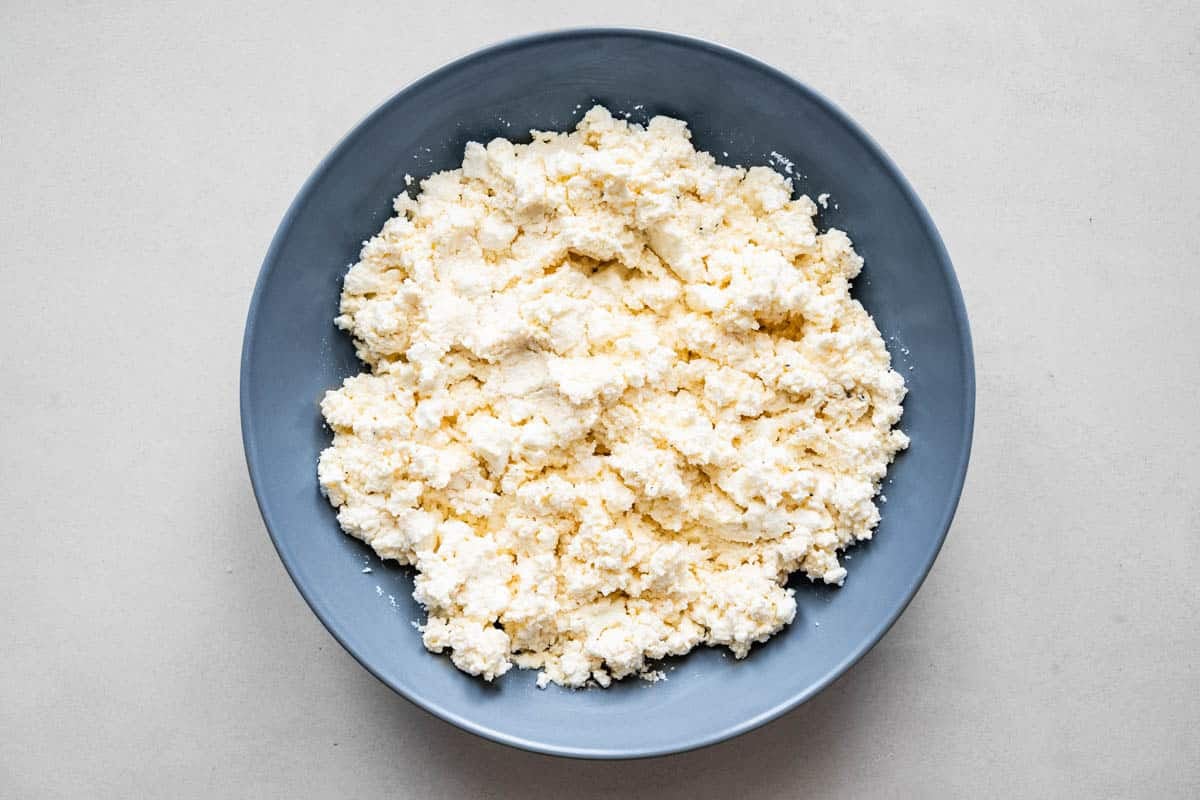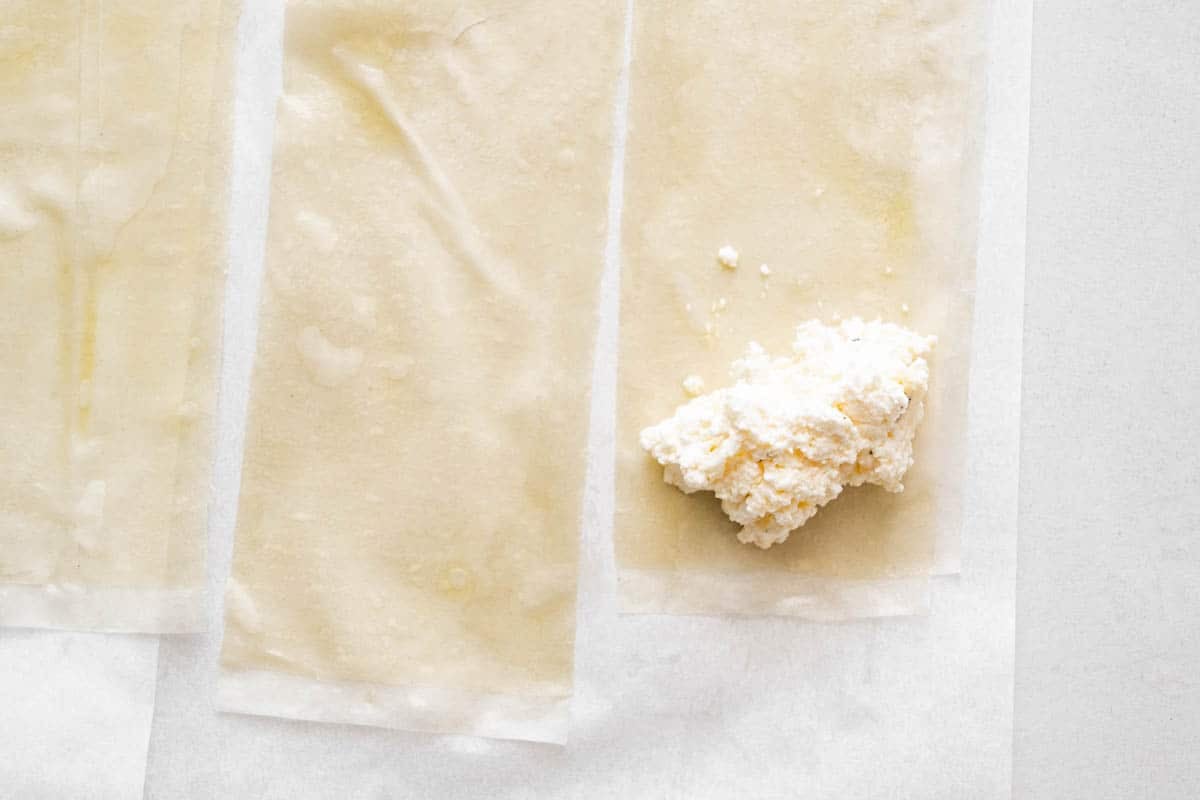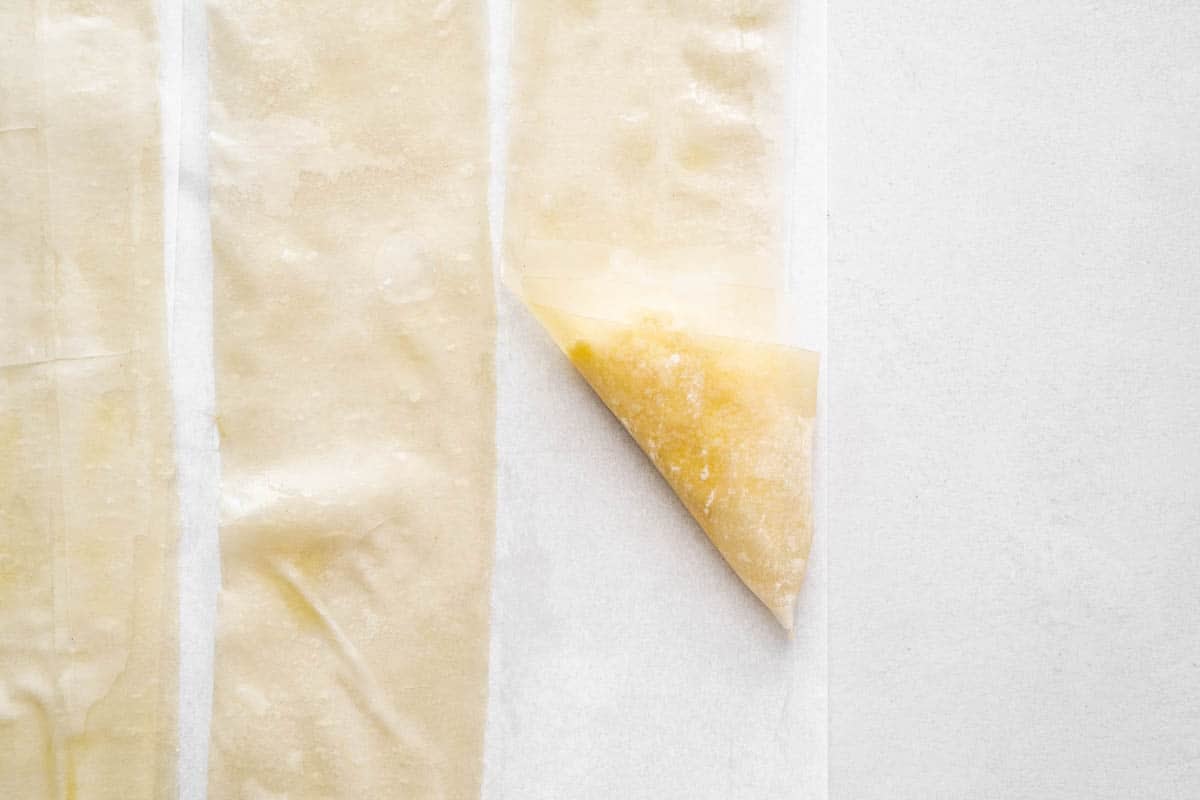Tiropita (τυρόπιτα) is a savory Greek filo pastry made of layers of crispy filo wrapped around a delicious creamy feta cheese and egg mixture. You can form them into individual triangles (tiropitakia) or bake as a large filo pie and portion into smaller pieces (tiropita). Just like Spanish Tuna and Beef Empanadillas, Middle Eastern Fatayer, or Tunisian Brik, these tasty bites are a breeze to make and their crust makes them perfect for meals on the go. Make ahead for lunches throughout the week, or serve as an easy appetizer. Plus, folding and shaping the triangles is a great activity for the whole family!
Ingredients for Tiropitakia
Throughout Greece, you will often find slightly different filling variations depending on the regional cheeses available. My version uses a combination of two Greek cheeses and optional herbs for layers of tangy, creamy, savory, and fresh flavor. Here are the traditional ingredients, as well as their easy-to-find substitutions.
Feta cheese: The base for the filling is authentic Greek Feta, labeled “PDO” or “Greek feta” at the store (find more information on labeling in the “What is Greek Feta PDO?” section). For this recipe, avoid substituting with cheese labeled Greek ”-style” feta, as it lacks the real sharp and tangy flavor of genuine Greek feta. Anthótiro cheese: In Greece, we add this farmhouse-style fresh cheese to balance the sharp flavor of the Feta. Whole milk cream cheese or drained ricotta, with its tangy flavor and creamy consistency, makes for a good substitute if you can’t find it. Egg: Binds the filling together. Extra virgin olive oil: Brushed on the filo pastry as we form the triangles. Use a high-quality olive oil, like our Koroneiki from the western coast of Crete. Filo: Also spelled “phyllo,” filo is a thin, flaky, and delicate pastry dough that can be found in the freezer section of your grocery store. Filo comes in different widths. The most common sizes are the thinnest kind (#4), and the medium-thickness filo (#7). You can use either one for this recipe. The standard size for each sheet, regardless of the thickness, is 14”x 18”. Salt and pepper: Seasoning enhances the flavor of both the filling and the dough.
What is Greek Feta PDO?
Greek Feta cheese is recognized by the European Union as a Protected Designation of Origin (PDO) traditional product. This means that in order for a cheese to be called Feta, it has to be made in defined geographical areas of Greece. These regions are rich in biodiversity of the natural flora (wild plants and herbs) and have certain weather conditions. It also refers to traditional methods of production. PDO guarantees a high-quality product. Greek Feta cheese a mixture of sheep and up to 30 percent goat milk, which is then stored in a brine for preservation and protected from exposure to air. Feta cheese made outside Greece is considered “Feta-style” cheese. It is typically made from cow’s milk, which acks the salty, tangy properties of authentic Greek feta. For that reason, it has a completely different flavor profile that I wouldn’t recommend for this recipe.
How to Make Tiropitakia
Homemade pastries may seem like a lot of work, but this recipe couldn’t be easier thanks to a simple filling and store bought filo dough. And, there’s nothing quite like warm homemade tiropitakia, fresh from the oven. To make:
Get ready: Remove a package of the thawed filo from the refrigerator and place on the counter for 30 minutes without opening it. Preheat your oven to 350˚F. Line two baking sheets with parchment paper. Make the filling: Crumble 8 ounces of feta into a medium mixing bowl. Add the 8 ounces of anthotiro, cream cheese, or drained ricotta. Lightly beat a large egg and add, along with 1/4 teaspoon of salt and pepper. Stir gently to combine. Layer the filo: When the filo has sat for 30 minutes at room temperature, lay one sheet horizontally in front of you on a clean work surface and brush lightly with olive oil. (Cover the remaining filo well with plastic wrap and a kitchen towel while you work.) Place a second sheet of filo on top of the first and brush with more olive oil. Cut the two layers crosswise into eight strips, each one about 2-inches wide. Add the filling: Stir the cheese and egg mixture one more time. Place one heaping spoonful at the end of each filo strip. Fold it: Lift one corner of the filo and fold it over to enclose the filling and make a triangle. Continue folding from side to side until you get to the end. Brush it with some olive to secure the end. Brush: place the filo triangle on one of the prepared baking sheets, seam-side down. Brush the top with olive oil to keep it moist. Fold the remaining Tiropitakia: Repeat the process with more filo dough until you have used up all the filling. Make sure to avoid overstuffing, and brush each finished triangle with olive oil to prevent drying. Bake: Bake each pan until the tiropitakia are golden brown, about 20-25 minutes. Let them cool briefly before serving.
Variation: Tiropita (Large Filo Pie)
You can use same essential ingredient list to make Tiropita, a larger pie that doesn’t require any individual folding. To make tiropita, use a 9”x 13” x 2” baking pan. The filling for this version is slightly different -– it needs to be looser and almost pourable. To achieve that consistency, add one more egg and about 3/4 cup of whole milk (or cream to make it extra decadent). To make Tiropita:
Prep the filo dough: Brush 12 sheets of filo with olive oil. Arrange 6 on the bottom of a 9” x 13” pan. Preheat your oven to 350˚F. Add the filling: Spread the filling evenly over the stack of filo. Top with filo: Layer the remaining filo on top. Trim the extra filo around the pan and roll in the edges to form a nice border. Score: Score the top into square pieces to make portioning easier once baked. Bake: Bake the tiropita until golden brown, about 30 minutes. Cool and slice: Allow to cool for 10 minutes, then slice into squares.
Tips for Working with Filo Dough
Store bought filo dough is easy, convenient, and surprisingly high-quality. The paper thin sheets may imply that they’re tricky to work with, but they’re truly a breeze when you thaw them properly. Here are some tips for working with filo dough:
Thaw the frozen filo dough in the refrigerator overnight and not at room temperature. Thawing filo dough at room temperature or in a warm environment can cause the dough to thaw too quickly, resulting in a soggy and difficult-to-work-with dough. Gradually thawing the filo dough in the refrigerator allows the dough to thaw evenly without becoming too wet or sticky. Bring filo to room temperature for 30 minutes before starting to work with it. The filo should still be cold, but a 30 minute rest will make it more pliable. Prevent drying. Remove the filo from its package and the plastic sleeve only when you’ve gotten everything ready. Keep unused sheets covered with a piece of plastic wrap, topped with a kitchen towel while you work. At the end, return any unused part of filo back to its box and into the refrigerator. (See tips below for how to use it.) Don’t sweat the small rips. If the filo tears a bit while you work with it, it is not a big deal. Filo is very forgiving! The tears will be hardly visible at the end.
How to Freeze Tiropitakia
Tiropitakia are the perfect make-ahead party appetizer. Once you form the triangles, you can brush on some olive oil, cover well with plastic wrap, and refrigerate until you need them the next day. For longer storage, freeze the unbaked tiropitakia. Arrange your unbaked filo triangles in a single layer on a parchment-lined tray. Place in the freezer until they’re completely frozen, then transfer them to a freezer bag and return to the freezer for up to one month. To bake, place the frozen tiropitakia on baking sheets. Brush the tops with some olive oil and bake until golden brown, about 30-45 minutes.
How to Serve Tiropitakia
Tiropitakia are the perfect treat to enjoy at any time of the day. They’re delicious as a mid-morning snack, as part of a brunch spread, meze addition. They can also be served as an elegant starter at a dinner party or as a light meal next to a traditional Greek salad. These tasty bites are truly irresistible. They’re usually the first food to go during parties. Make more than what you think you want and you will be thankful you did! Browse all Mediterranean Recipes.
Phyllo Dough Meat and Feta Rolls
Sheet Pan Phyllo Pizza (Crispy Pizza Dough)
Phyllo-Wrapped Baked Feta with Honey
Spanakopita Recipe (Greek Spinach Pie)
Visit Our Shop. Our Signature Private Reserve and Early Harvest Extra Virgin Olive Oils, Sourced Directly from Family Farms in Greece.















